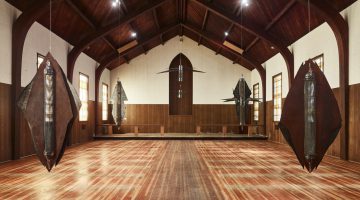By Chris Rusak
The innards between walls, the voids between floors, the dark provinces of musty storage spaces, these are the omitted destinations of our everyday that hold up the structures we occupy, yet often see only when something falls through a crack or malfunctions. Many of these spaces persist in darkness, lit only by the infiltration of a sledgehammer or a flashlight, and still shadows will exist. Decay and detritus, or a curious and scared child, often bring permanent light to those materials which construct those spaces; however, for our pleasure and psycho-subterranean exploration, the confident curiosity of artist Andy Vogt liberates these dark confines and constructs perceptual challenges out of the ordinary elements bounding together the structures in which many of us reside. His solo show “Submerged on the Surface” is currently on view at Eli Ridgway Gallery, San Francisco, until at least June 22, 2013.
Structural reveals begin with an excavation, and on the lower floor of the gallery hang five compositions which open as a perfect passageway into Vogt’s surrounding work. In particular, the central composition, Partial Excavation (2013), is where much of the artist’s illusion begins. At first glance this work appears painterly, its strokes immediately beginning to define form and space, crafted, perhaps, through delicate masking and the scrape of a palette knife. However, Vogt works with wet, pigmented plaster and equally modified strips of melamine, embedding the latter into the former to give the appearance of incised areas containing oil paint. This working method immediately reinforces the subject matter: standing amongst the thresholds of a molting basement, one is unsure whether beneath these shadows lie a staircase, a wood stove, or the critical supports of a coal mine preventing our death. Lines gather into sketches for sculptural assemblages of sawhorses, photographed on long expired film and left for dead years before their chemical exposure to darkroom developer. Two solo, slender splinters — one originating two-thirds down the left edge and another originating precisely from the top-right corner — hint at an organization by perspective, but the shapeshifting planes arranged from the frenetically scratchy, jaggedly edged submersions create a confusion whose strength overpowers any attempt at true order. Together, the figurative decay and distorted connectivity set the scene for the surrounding works.
First, though, taking pause, examining the neighboring panels and their reliance on chemical inducement, reveals an element of alchemy, work catalyzed with what others may consider refuse and damage. This is the work of a scientist and geometer who has taken the time to consider his materials and his purpose; what initially seems like paintings are actually recreations of the processes building contractors originally would have used with the now abandoned and refashioned materials. And, these are paintings, no doubt, with an aesthetic expressiveness strong enough to stand alone outside the surrounding context of their sculptural iterations. But, like an auteur scribing a frame-in-frame, Vogt has used wood supports to hold slathered plaster and lift structure — the initial process to building the rooms inside San Francisco Victorians, from which much of his materials are sourced, a point critic DeWitt Cheng has previously noted reviewing the artist’s efforts.
This conceptual playfulness is a common element throughout Vogt’s work. Opposite the five paintings is a wooden sculptural composition, OSB (outer surface broken) (2013), notable for its visible presence of text, stamped, presumably by its original manufacturer, across the top strip of wood: RATED SHEATHING. One of two compositions in the show that place whitewashed strips of wood on their edge, some cleanly cut, others as if snapped across a knee, these constructions confirm the sly calculation within the artist’s practice. Each strip is a piece of oriented strand board, more commonly referred to as particle board in a lumber yard, manufactured from layered flakes, shreds, and shards of wood, solidified with adhesive media. The title, then, plays on the name of its substance, OSB. The stamped text returns to close a conceptual loop for the work: sheathing — traditionally the outer surface of a building and a term for both the materials and process of its fabrication — has been turned on its side and elbowed through, its knee-cracked shards the deckled, sharpened wit of an open invitation intentionally lain bare on the outer broken surface of a structure now containing its viewer.
The largest work downstairs, the perfectly flush, trichromatic wall relief Drained (2013), presents in grand scale the main material used in most of the works. Constructed of laths, or thin strips of wood commonly employed to create a supporting structure for plaster walls, these works balance the aforementioned paintings resting on the other side of his conceptual fulcrum. Stretching over ten feet long, Drained challenges a viewer to question its flatness, to inquire how its wideness and skews stretch and distort one’s perception of space. Is our vantage point directly opposite the work or are we viewing an illusion of space from above? The implication of continuity by the dark hued horizontal lines of the top edge works to push a viewer away; viewers that approach the work up close will discover an exceptionally clean installation with an almost indiscernible implementation of weightlessness, the scant few reflections of tiny, embedded nails revealing the arrangement’s hold. The contrasting hues do suggest shadow, but the presence of actual shadow elsewhere, and the bottom-left incongruous extension of wood, drains the argument that this is a simple 2D compression of 3D space of its fight.
The actual shadows of Shadeshape 3 (2012) instead capture space and work to cajole a viewer into the darker elements on display. Constructed of interrupted zigzags bound between an illusory, frank window frame, shadow becomes as material as the wood. Complex cuts, precise sizes, and a multitude of angles come together as a naked, open lean-to, breathing an anxious delicacy that could crumble under the slightest bump. This work is a Constructivist’s wet dream. Beautifully, almost impeccably constructed, yet one minute area reveals the body of a nail, whereas elsewhere we only see hints of trimmed silver heads. But, in a very harmonic way, this easter egg for viewers who take the time to engage the work offers counterpoint by infusing another angle for consideration — a hint of the angles one must take to construct a handsome work with such á plomb. The work’s dark suggestions zag, too. A quick turn away and a quick glance behind and one can imagine moonlit shadows from a jail cell, a whispering sadness tucked away in some of these pieces, a dying nostalgia for the cities of yesterday being destroyed and replaced with cut-rate drywall and towering columns of rebar and cement. Whereas plaster used to hold onto the wood surfaces carpenters nailed side by side, it now conforms to the cardboard walls between which it is extruded. Aside from the wall that supports it, Shadeshape 3 holds on to nothing. An interesting connection to note: in one of the five paintings, Forming in the Wall (2013), a twist of neck to the right reveals another, possibly unconscious addition of text; the lines of embedded melamine form the word CELL in haphazard fashion. Does Vogt scratch only light into our jail cell?
There are some other interesting problems within this show to consider, particularly the unclear implications of the work Boundary Lines (2012) which shares the corner space with Shadeshape 3. More laths create a composition of irregular negative spaces, irregular and incongruent diagonal angles, and irregularly applied whitewash, looking here tinted with a faint hint of blue and there blushing orange. As such, this leads to an overall irregular verticality, a confused movement up and down. The work is displayed on a constricted, low hanging wall, forcing viewers’ focal point toward the pair of short, upper horizontal slats, creating the effect of a sagging, downward composition. However, shifting one’s vantage point by crouching and lowering one’s center of gravity, the direct focal point shifts to the smallest slat within the whole composition, which lies much closer to the geographical center of the work, rather than its highest edge. This shift tunes the verticality of the work, consequently actuating the dynamic motion of the incongruous angularity into something much more rhythmically contrasting, a diagonal left-right counterpoint which makes the work hum instead of creak. This work would be very interesting to engage looking comfortably upwards, or at the very least, unconstrained by the foreign materials of the actual building which surround it: working pipes, working ceilings, working doors.
Another piece in the show seems awkwardly present in the room. Altered Mirror (2013) unites mirrored Plexiglas and a spotlight to force light and shadow onto a wall, but through a perfectly rectangular lens which juts perfectly perpendicular from the wall — the only work to enter a viewer’s space so piercingly sharp. While this work may be the creak of a door into future endeavors by Vogt, a provocative one at that, perhaps this is one reveal too many. Nonetheless, its placement within the gallery isn’t too disruptive to the overall continuity. In contrast, the disruption of space by Wedge (2013) creates a fantastic volume of fluorescence to circle under, or incandescence should you ask nicely for a dim of the lights. And the play of Walls (2013) could ensnare the best of us for hours as we lose ourselves in its maze of no passage, a work which allows entry and exit, but seems to snag onto us as we ride its planes shifting on a central axis; we’re never quite sure when horizontality merely tilts or verticality slides down.
In total, “Submerged on the Surface” is a wonderful effort of work that truly gets below the surface. The craftsmanship of each piece is commendable, objects which affect fragility despite their various hefts, attentive assembly, and durable construction. If Vogt continues to work with building materials, continues to explore and push their limits, we will certainly see the discourse in geometric and non-objective artwork amplified, to the benefit of all. But, should the illuminated reveal suggest the end of wood and plaster, the confident curiosity assembled before us suggests Vogt will have no problem shaping light into a palpable, exquisite presence.
Chris Rusak is an artist currently inhabiting San Francisco.








